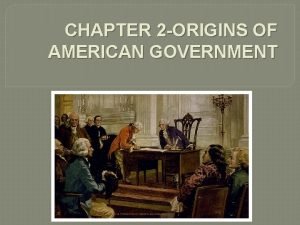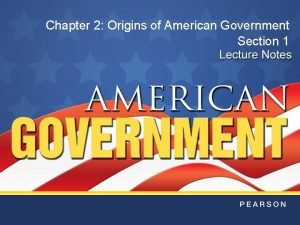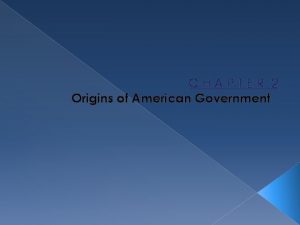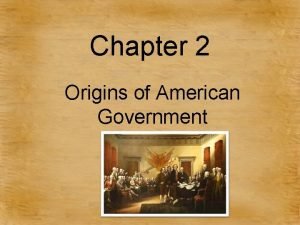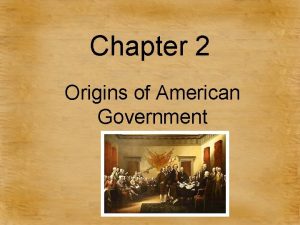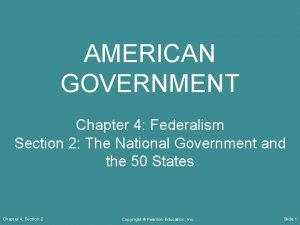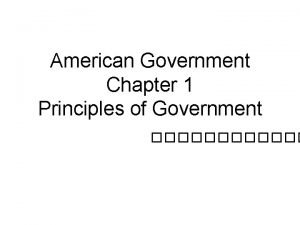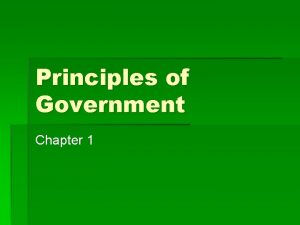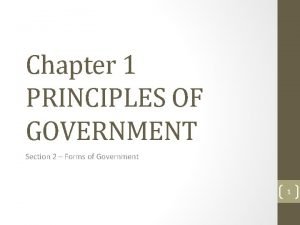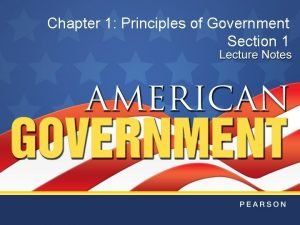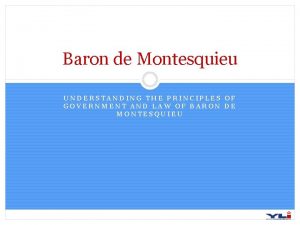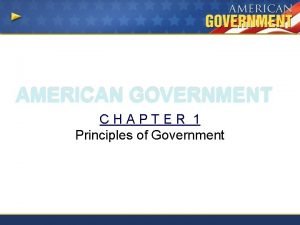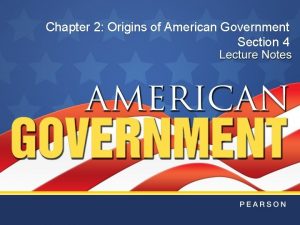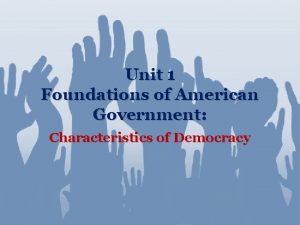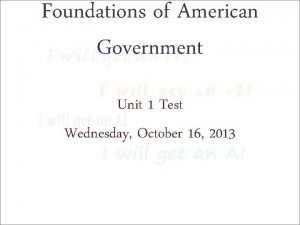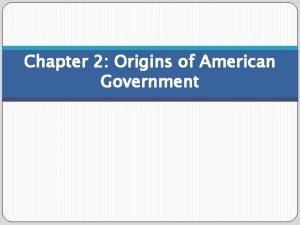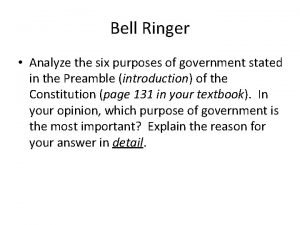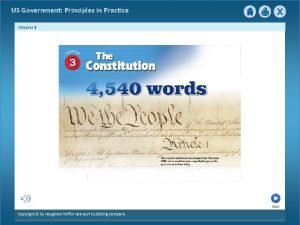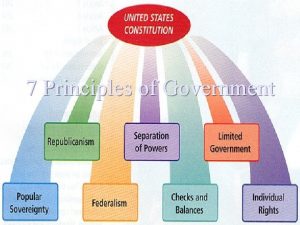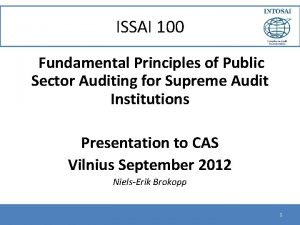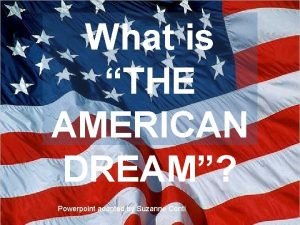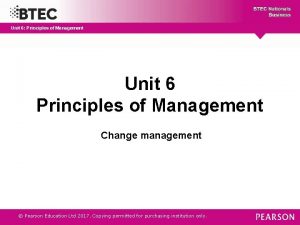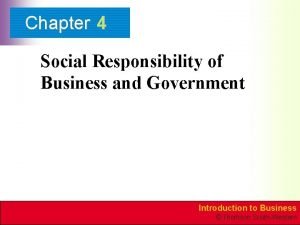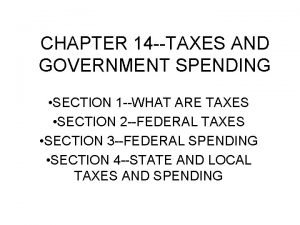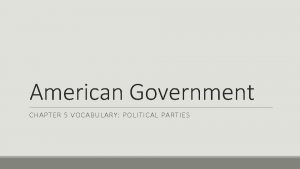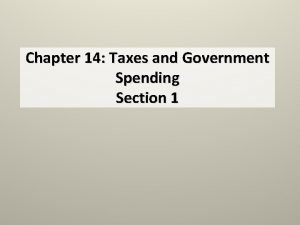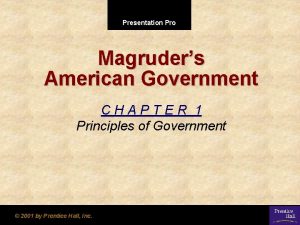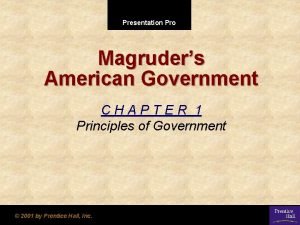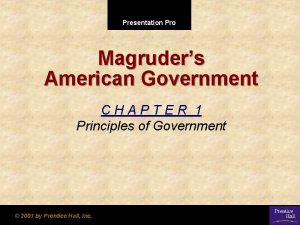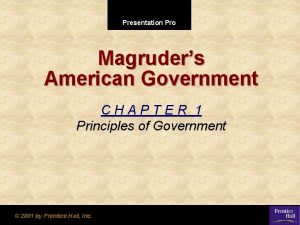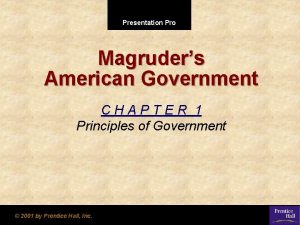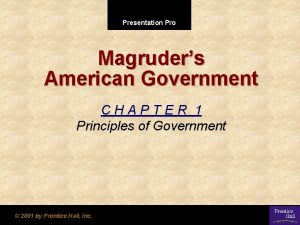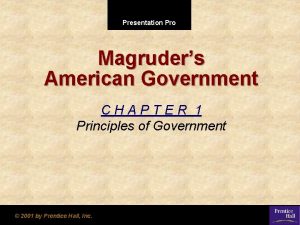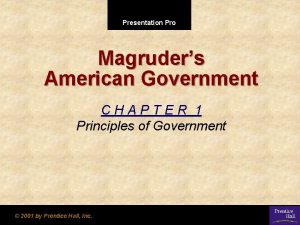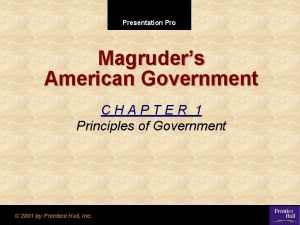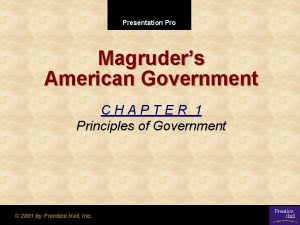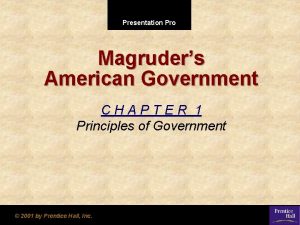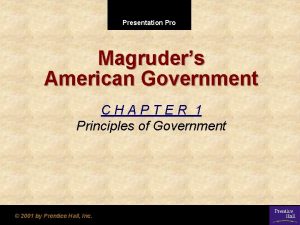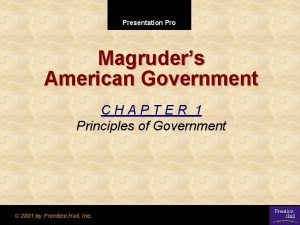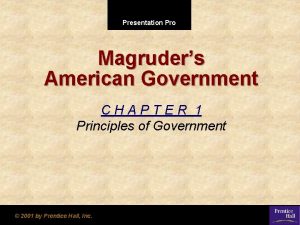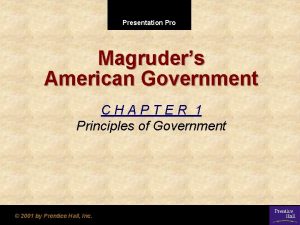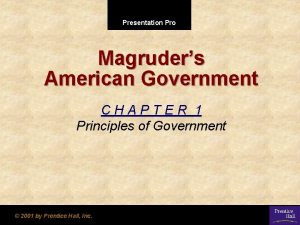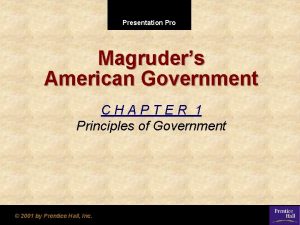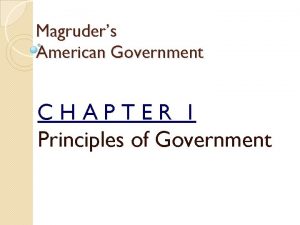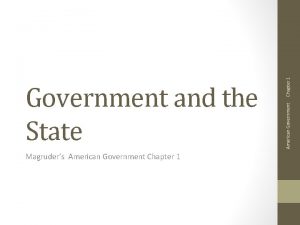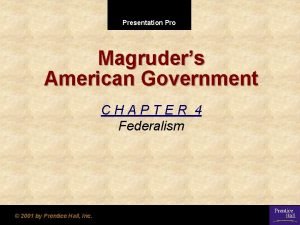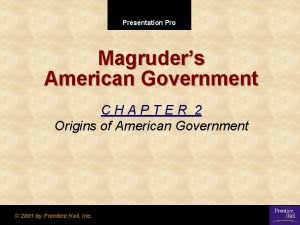Presentation Pro Magruders American Government CHAPTER 1 Principles





































- Slides: 37

Presentation Pro Magruder’s American Government CHAPTER 1 Principles of Government © 2001 by Prentice Hall, Inc.

CHAPTER 1 Principles of Government SECTION 1 Government and the State SECTION 2 Forms of Government SECTION 3 Basic Concepts of Democracy Go To Section: 1 2 3 Chapter 1

SECTION 1 Government and the State • How is government defined? • What are the basic powers that every government holds? • What are the four defining characteristics of the state? • How have we attempted to explain the origin of the state? • What is the purpose of government in the United States and other countries? Go To Section: 1 2 3 Chapter 1, Section 1

What Is Government? Government is the institution through which a society makes and enforces its public policies. Go To Section: 1 2 3 Chapter 1 Section 1

The State The state can be defined as having these four characteristics: Go To Section: 1 2 3 Chapter 1, Section 1

Origins of the State The Force Theory • The force theory states that one person or a small group took control of an area and forced all within it to submit to that person’s or group’s rule. The Evolutionary Theory • The evolutionary theory argues that the state evolved naturally out of the early family. The Divine Right Theory • The theory of divine right holds that God created the state and that God gives those of royal birth a “divine right” to rule. The Social Contract Theory • The social contract theory argues that the state arose out of a voluntary act of free people. Go To Section: 1 2 3 Chapter 1, Section 1

The Purpose of Government The main purposes of government are described in the Preamble of the Constitution of the United States: “We the People of the United States, in Order to form a more perfect Union, establish Justice, insure domestic Tranquility, provide for the common defence, promote the general Welfare, and secure the Blessings of Liberty to ourselves and our Posterity, do ordain and establish this Constitution for the United States of America. ” Go To Section: 1 2 3 Chapter 1, Section 1

Section 1 Review 1. A government is (a) the institution through which a society makes and enforces its public policies. (b) a collection of people. (c) always democratic. (d) the organization representing farms and industries. 2. A state has the following four characteristics: (a) population, territory, sovereignty, and government. (b) sovereignty, a perfect union, welfare, and territory. (c) people, places, force, and divine right. (d) justice, defense, liberty, and domestic tranquility. Want to connect to the� Magruder’s link for this. Click chapter? Here! Go To Section: 1 2 3 Chapter 1, Section 1

Finish your Group Project from last Friday • Using pages from the telephone book write down agencies from: Federal Government State Government County Government City Government At your tables, discuss and answer the questions. Be prepared to discuss as a group. Go To Section: 1 2 3

In Partners: • • There are 3 Questions at each table. Using the page numbers listed for research and to help you think in depth about the questions: Answer the question Write the answer on the page Pass it on to the next partnership Continue the process until the 3 questions are answered. Even though you might agree with the previous partners’ answers, you must add a new thought to it. Find something different to add. Go To Section: 1 2 3

Discussion of Purposes of Government Project Results: Go To Section: 1 2 3

Bell Work: • Have you ever referred to someone as a dictator, in anger or as a joke? • Have you ever taken an informal vote to make a democratic decision on where to eat or which movie to see? Go To Section: 1 2 3

If you have ever done either of these, you were referring to two types of government that are common throughout the world. Go To Section: 1 2 3

SECTION 2 Forms of Government • How can we classify governments? • How are systems of government defined in terms of who can participate? • How is power distributed within a state? • How are governments defined by the relationship between the legislative and executive branches? Go To Section: 1 2 3 Chapter 1, Section 2

Can you name the 3 ways to classify government? Go To Section: 1 2 3

Classifying Governments can be classified by three different standards: (1) Who can participate in the governing process. (2) The geographic distribution of the governmental power within the state. (3) The relationship between the legislative (lawmaking) and the executive (law-executing) branches of the government. Go To Section: 1 2 3 Chapter 1, Section 2

Classification by Who Can Participate Democracy • In a democracy, supreme political authority rests with the people. • A direct democracy exists where the will of the people is translated into law directly by the people themselves. • In an indirect democracy, a small group of persons, chosen by the people to act as their representatives, expresses the popular will. Go To Section: 1 2 3 Dictatorship • A dictatorship exists where those who rule cannot be held responsible to the will of the people. • An autocracy is a government in which a single person holds unlimited political power. • An oligarchy is a government in which the power to rule is held by a small, usually selfappointed elite. Chapter 1, Section 2

Do you feel that the officials that we elect always represent or try to represent our opinions? Go To Section: 1 2 3

Classification by Geographic Distribution of Power Confederate Government Unitary Government • A unitary government has all powers held by a single, central agency. • A confederation is an alliance of independent states. Federal Government • A federal government is one in which the powers of government are divided between a central government and several local governments. • An authority superior to both the central and local governments makes this division of power on a geographic basis. Go To Section: 1 2 3 Chapter 1, Section 2

Classification by the Relationship Between Legislative and Executive Branches Go To Section: 1 2 3 Chapter 1, Section 2

Forms of Government Go To Section: 1 2 3 Chapter 1, Section 2

Section 2 Review 1. In a democracy, (a) independent states form an alliance. (b) supreme political authority rests with the people. (c) those who rule cannot be held responsible to the will of the people. (d) the rule by a few, select individuals regulates the will of the people. 2. The United States government has the following characteristics: (a) confederate, parliamentary, and dictatorship. (b) unitary, presidential, and democracy. (c) federal, presidential, and democracy. (d) unitary, parliamentary, and dictatorship. Want to connect to the� Magruder’s link for this. Click section? Here! Go To Section: 1 2 3 Chapter 1, Section 2

Assignment: • Create a flow chart using the 3 characteristics that we have talked about today. Who can Participate? Geographic Distribution of Power? Relationship between Legislative and Executive Branches • Your flow chart should help others to identify what type a particular government is. • In your chart use conditional statements such as, “If, then” throughout the chart. Go To Section: 1 2 3

Bell Work: • Suppose the tomorrow you will vote in a national election, in which you will freely choose among the candidates of several parties. You will then stand in line for hours waiting to buy food at the government run market. What is wrong with this picture? Go To Section: 1 2 3

SECTION 3 Basic Concepts of Democracy • What are the foundations of democracy? • What are the connections between democracy and the free enterprise system? • How has the Internet affected democracy? Go To Section: 1 2 3 Chapter 1, Section 3

James Brayce’s Assessment of Democracy: • “No government demands so much from the citizen as Democracy, and none gives so much back. ” • What does democratic government demand from you? • What does it give you in return? Go To Section: 1 2 3

Democracy exists in the United States because the American people believe in its basic concepts. It will continue to exist only for as long as we continue to subscribe and practice the concepts of democracy. Go To Section: 1 2 3

Foundations The American concept of democracy rests on these basic notions: (1) A recognition of the fundamental worth and dignity of every person; (2) A respect for the equality of all persons; (3) A faith in majority rule and an insistence upon minority rights; (4) An acceptance of the necessity of compromise; and (5) An insistence upon the widest possible degree of individual freedom. Go To Section: 1 2 3 Chapter 1, Section 3

Worth of the individual: • Each individual, no matter his or her place in life, is a separate and distinct being. • At times, the welfare of one or a few individuals is subordinated to the interests of the many in a democracy. • Examples could be paying a tax or obeying traffic signals. Go To Section: 1 2 3

Equity of all persons • Equality of opportunity • Equality before the law. • No person should be held back for reasons such as those based on race, color, religion, or gender. Go To Section: 1 2 3

Majority Rule, Minority Rights • Democracy argues that a majority of the people will be right more often than they will be wrong. • Democracy can be described as trial-and- error or an experiment in finding satisfactory ways to order human relations. Go To Section: 1 2 3

Necessity of Compromise: • Public decision making must be a matter of give-and take among the different competing interests. • Compromise is an essential part of the democratic concept: It puts the individual first and It insists that each individual is the equal of all others. Most public questions can be answered in several ways. Ex: How should a city pay for the paving of a public street? Compromise is a way of achieving majority agreement. Go To Section: 1 2 3

Individual Freedom • Absolute freedom can exist only in a state of anarchy or the total absence of government. • Justice Oliver Wendell Holmes said this about individual rights, “ The right to swing my fist ends where the other man’s nose begins. ” Go To Section: 1 2 3

Democracy and the Free Enterprise System • The free enterprise system is an economic system characterized by private or corporate ownership of capital goods; investments that are determined by private decision rather than by state control; and determined in a free market. • Decisions in a free enterprise system are determined by the law of supply and demand. • An economy in which private enterprise exists in combination with a considerable amount of government regulation and promotion is called a mixed economy. Go To Section: 1 2 3 Chapter 1, Section 3

Democracy and the Internet • Democracy demands that the people be widely informed about their government. • Theoretically, the Internet makes knowledgeable participation in democratic process easier than ever before. • However, all data on the World Wide Web is not necessarily true, and the long-term effects of the Internet on democracy has yet to be determined. Go To Section: 1 2 3 Chapter 1, Section 3

Section 3 Review 1. All of the following are basic notions found in the American concept of democracy EXCEPT (a) a recognition of of the fundamental worth and dignity of every person. (b) a respect for the equality of all persons. (c) the rule of government by a single individual. (d) an acceptance of the necessity of compromise. 2. In a free enterprise system, the means of capital are owned (a) by private and corporate entities. (b) by government agencies. (c) by only the agricultural sector. (d) equally by the collective citizenry. Want to connect to the� Magruder’s link for this. Click section? Here! Go To Section: 1 2 3 Chapter 1, Section 3

• http: //www. youtube. com/watch? v=S 1 MN 3 ba. Qk. HY Go To Section: 1 2 3
 Magruder's principle
Magruder's principle Chapter 2 american government
Chapter 2 american government Origins of american government vocabulary
Origins of american government vocabulary Chapter 2 origins of american government answer key
Chapter 2 origins of american government answer key Chapter 2: origins of american government worksheet answers
Chapter 2: origins of american government worksheet answers Chapter 2 lesson 1 origins of american government
Chapter 2 lesson 1 origins of american government Chapter 2 origins of american government
Chapter 2 origins of american government American government chapter 4
American government chapter 4 Principles of government chapter 1 answers
Principles of government chapter 1 answers Principles of government chapter 1
Principles of government chapter 1 Chapter 1 principles of government
Chapter 1 principles of government Chapter 1 principles of government
Chapter 1 principles of government Chapter 1 section 1 government and the state
Chapter 1 section 1 government and the state Chapter 1 principles of government study guide answer key
Chapter 1 principles of government study guide answer key Chapter 1 principles of government
Chapter 1 principles of government The macro pro pro maxcharltonmacrumors
The macro pro pro maxcharltonmacrumors National government vs federal government
National government vs federal government Origins of american government section 4
Origins of american government section 4 Government unit 1 study guide
Government unit 1 study guide Unit 1 foundations of american government
Unit 1 foundations of american government Origins of american government section 1
Origins of american government section 1 Foundations of american government unit test
Foundations of american government unit test Origins of american government section 1
Origins of american government section 1 6 purposes of government
6 purposes of government United states government: principles in practice
United states government: principles in practice Limited government
Limited government Issai 100
Issai 100 American dream powerpoint presentation
American dream powerpoint presentation 5cm labor
5cm labor 4 maneuvers of leopold
4 maneuvers of leopold Avoid over use of one common texture on the
Avoid over use of one common texture on the Principles of management unit 6
Principles of management unit 6 Chapter 4 social responsibility of business and government
Chapter 4 social responsibility of business and government Three branches of government flocabulary answers
Three branches of government flocabulary answers Chapter 14: taxes and government spending section 1
Chapter 14: taxes and government spending section 1 Us government chapter 5 vocabulary
Us government chapter 5 vocabulary Chapter 14 taxes and government spending
Chapter 14 taxes and government spending Chapter 1: foundations of government worksheet answers
Chapter 1: foundations of government worksheet answers

